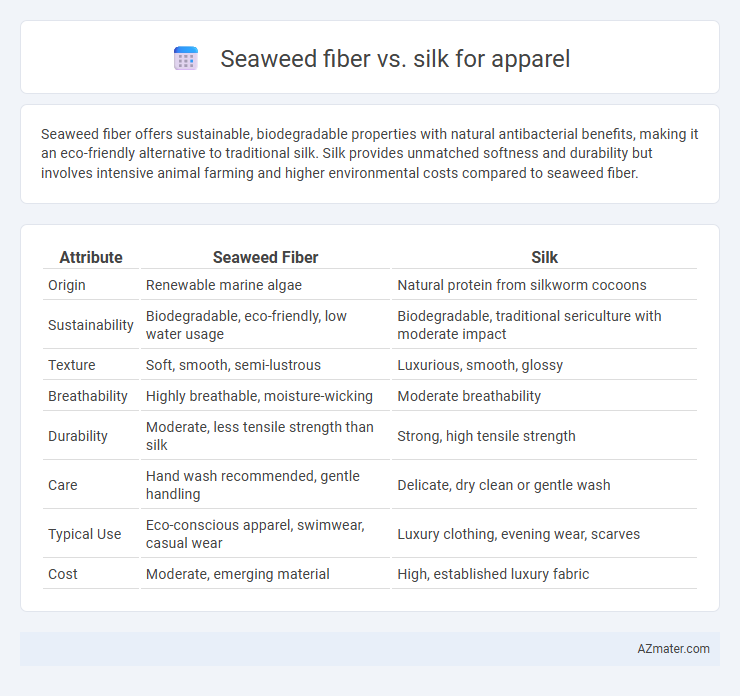Seaweed fiber offers sustainable, biodegradable properties with natural antibacterial benefits, making it an eco-friendly alternative to traditional silk. Silk provides unmatched softness and durability but involves intensive animal farming and higher environmental costs compared to seaweed fiber.
Table of Comparison
| Attribute | Seaweed Fiber | Silk |
|---|---|---|
| Origin | Renewable marine algae | Natural protein from silkworm cocoons |
| Sustainability | Biodegradable, eco-friendly, low water usage | Biodegradable, traditional sericulture with moderate impact |
| Texture | Soft, smooth, semi-lustrous | Luxurious, smooth, glossy |
| Breathability | Highly breathable, moisture-wicking | Moderate breathability |
| Durability | Moderate, less tensile strength than silk | Strong, high tensile strength |
| Care | Hand wash recommended, gentle handling | Delicate, dry clean or gentle wash |
| Typical Use | Eco-conscious apparel, swimwear, casual wear | Luxury clothing, evening wear, scarves |
| Cost | Moderate, emerging material | High, established luxury fabric |
Introduction to Seaweed Fiber and Silk in Apparel
Seaweed fiber, derived from sustainably harvested algae, offers a biodegradable and eco-friendly alternative to traditional fabrics with natural moisture-wicking and antibacterial properties ideal for apparel. Silk, produced from silkworm cocoons, is prized for its luxurious softness, strength, and natural sheen, making it a high-end choice in fashion and textile industries. Both fibers provide unique benefits, with seaweed fiber emphasizing sustainability and innovation, while silk is renowned for elegance and durability in clothing.
Origins and Production Processes
Seaweed fiber originates from sustainably harvested marine algae, processed through eco-friendly methods involving drying, blending with cellulosic fibers, and using minimal chemicals to create soft, biodegradable textiles. Silk, derived from silkworm cocoons, involves a labor-intensive process where larvae spin fibers that are carefully reeled and woven, demanding significant water and energy resources. The distinct origins and production processes highlight seaweed fiber's alignment with sustainable fashion and silk's traditional, resource-heavy craftsmanship.
Sustainability and Environmental Impact
Seaweed fiber is a sustainable alternative to silk, produced using less water, energy, and chemical inputs, which significantly reduces its environmental footprint. Unlike silk, which relies on mulberry cultivation and silkworm farming that can strain ecosystems, seaweed fiber is rapidly renewable and promotes ocean health by absorbing carbon dioxide. Seaweed-based fabrics biodegrade more easily and reduce microplastic pollution compared to silk blends, making them an eco-friendly choice for sustainable apparel.
Physical and Mechanical Properties
Seaweed fiber exhibits high moisture absorption and biodegradability, offering excellent breathability and natural UV protection suitable for eco-friendly apparel. Silk demonstrates superior tensile strength, elasticity, and a smooth, luxurious texture that provides durability and comfort in high-end fashion garments. Comparing thermal conductivity, seaweed fiber maintains a cooler touch, whereas silk adapts to body temperature, enhancing wearability across diverse climates.
Comfort and Skin Benefits
Seaweed fiber offers exceptional breathability and moisture-wicking properties, making it ideal for sensitive skin and all-day comfort, while silk provides a smooth, hypoallergenic texture that naturally regulates temperature and reduces friction against the skin. Seaweed fiber is rich in vitamins and minerals like iodine and calcium, promoting skin hydration and soothing inflammation, whereas silk contains fibroin proteins that enhance skin elasticity and reduce irritation. Both fibers excel in comfort and skin benefits, but seaweed fiber stands out for its sustainable extraction and enhanced skin-nourishing qualities.
Aesthetic Qualities and Versatility
Seaweed fiber offers a unique matte sheen and a soft, breathable texture that enhances comfort while providing natural antibacterial properties ideal for activewear. Silk boasts a luxurious, smooth surface with a natural luster and excellent drape, making it a preferred choice for high-end fashion and formal apparel. Both fibers exhibit versatility in dye absorption and design adaptability, yet seaweed fiber excels in eco-friendly, casual wear, whereas silk remains unmatched in elegance and sophistication.
Durability and Maintenance
Seaweed fiber offers moderate durability for apparel, with natural antibacterial properties that help reduce odor and maintain freshness, requiring gentle washing to preserve its integrity. Silk, renowned for its exceptional strength and elasticity, provides superior durability but demands delicate care, such as hand washing or dry cleaning, to prevent damage from abrasion and moisture. Both fibers necessitate mindful maintenance practices to extend garment lifespan, with silk generally requiring more specialized handling despite its higher tensile strength.
Cost and Market Availability
Seaweed fiber offers a cost-effective alternative to silk, with production expenses generally lower due to sustainable sourcing and simpler processing methods. Seaweed fiber is gaining market availability rapidly as eco-friendly fashion brands increase demand, while silk remains more expensive and less accessible due to labor-intensive harvesting and limited supply. The expanding seaweed fiber market appeals to budget-conscious consumers seeking sustainable apparel, contrasting with silk's premium status and niche customer base.
Fashion Innovation and Trends
Seaweed fiber offers a sustainable alternative to traditional silk, combining eco-friendly production with a soft, breathable texture ideal for modern apparel. Fashion innovation leverages seaweed fiber's natural antibacterial properties and biodegradability, meeting rising consumer demand for environmentally conscious textiles. Silk, known for its luxurious sheen and strength, remains a staple in high-end fashion, but seaweed fiber's unique bio-based composition is driving new trends in sustainable luxury and performance wear.
Future Outlook in Textile Industry
Seaweed fiber offers a sustainable alternative to traditional textiles, boasting biodegradable properties and low environmental impact, which aligns with growing consumer demand for eco-friendly apparel. Innovations in seaweed fiber processing aim to enhance its durability and softness, positioning it as a viable competitor to luxurious silk in the high-end fashion market. The future textile industry is likely to witness increased adoption of seaweed fiber as advancements reduce costs and improve scalability, fostering a shift toward renewable and ethical fabric sources.

Infographic: Seaweed fiber vs Silk for Apparel
 azmater.com
azmater.com